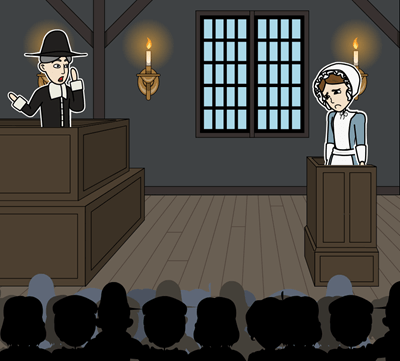Student Activities for The Crucible
Essential Questions for The Crucible
- How important should someone's word be in testimony?
- How do secrets hold power over people?
- Is it ever okay to lie?
- How far would you go to defend your honor?
The Crucible Summary
The Crucible by Arthur Miller is an account of the Salem Witch trials, which took place in Massachusetts during the 1600s. The play centers on a community of Puritans who lose their righteousness as they fall victim to the spreading of lies and deceit. Abigail Williams, the reverend's niece, starts the hysteria of witchcraft to get revenge on her lover’s wife, Goody Proctor. Written in the 1950s, Miller used the witch hunt as a metaphor for the 'Red Scare', the growing threat of communism in the United States during the 1950s.
In the play, good Christians are accused of witchcraft by Abigail and many other young girls in the community. They lie to save themselves. When others in town see their accusations are being taken seriously, they begin to use accusations to settle old feuds, to gain land or power, and for vengeance against those they dislike.
John Proctor, Abigail’s former lover, becomes the martyr, refusing to sign a decree stating he consorted with the Devil. He refused to save his life through a lie, which would make him no better than his accusers. He also realized that signing would ruin his family name for centuries to come. In the end, he is hanged as a witch.
More Activity Ideas for The Crucible
- Use a storyboard to show precise causes and effects of events in the play.
- Use a storyboard to depict one act or scene at a time.
- Create a T-Chart storyboard with the theme of choices and consequences.
- Add a presentation to any storyboard project.
How To Facilitate a Discussion on The Crucible in Class
Introduce Communism
Begin by explaining the basic hidden meaning in the story which is the concept of communism. Assess the prior knowledge of the students and ask them what they know about communism or perhaps other systems such as socialism, capitalism, etc. Build the lecture based on the responses of the students.
Begin Discussion on the Story
Once students are more familiar with the concept of communism, read the story with the help of the students. Make sure students do not have any problems in understanding due to complex vocabulary. Clear any confusion on the spot.
Discuss Historical Context
The Crucible discussed many significant events that took place in history such as the Salem Witch Trials. Make sure the students are familiar with the concept of Witch Hunt and why it happened also discuss any hidden motives that could have influenced these murders and killings.
Discuss the Issues Raised
Discuss with the class the nuanced problems brought up in the play, such as mass panic, honesty, and the abuse of power. Encourage the students to voice their thoughts while also taking into account different viewpoints.
Organize Engaging Activities
Include exercises like role-playing, small-group conversations, or artistic endeavors that are connected to the play's ideas and characters. Students can also organize a session to carefully analyze each and every event in the story and link it with some history. These exercises might provide students with a practical way to learn the subject.
Frequently Asked Questions About The Crucible by Arthur Miller
When was the story written and who is the author of the story?
"The Crucible" was written by Arthur Miller in 1953, a year marked by fervent anti-communist prejudice in the United States, during the McCarthy era. However, the story is set in the 1600s during the era of the Salem Witch Trials which has been used as an Allegory.
Who are the primary characters in the story?
The primary figures in "The Crucible" include, among others, John Proctor, Elizabeth Proctor, Abigail Williams, Reverend Parris, Reverend Hale, and Deputy Governor Danforth.
How is the title of the story “The Crucible” important to the story?
Metals are melted and purified in crucibles, which are heated to extremely high temperatures. It stands in for the difficult and changing experiences the play's protagonists go through as the outcome of the witch trials. Students can reflect on this sort of symbolism used in the story to gain a deeper understanding.
Pricing for Schools & Districts
© 2024 - Clever Prototypes, LLC - All rights reserved.
StoryboardThat is a trademark of Clever Prototypes, LLC, and Registered in U.S. Patent and Trademark Office








